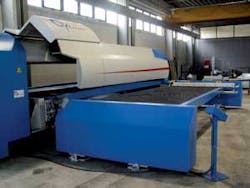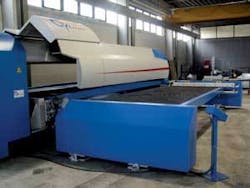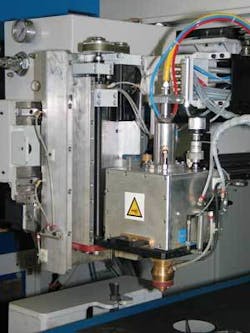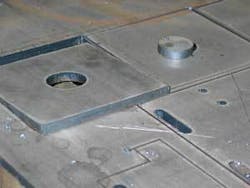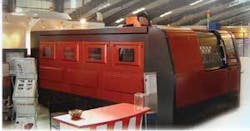Two-dimensional fiber-laser cutting premieres
Fiber lasers cut sheet metal efficiently
David A. Belforte and Antonio Vendramini
Sheet-metal cutting is the single largest, in terms of sales, global industrial laser application. In 2006, total revenues for this application sector exceeded $2.7 billion and are projected for continued growth at 10% or higher for the foreseeable future.
To date, sheet-metal cutting has been accomplished by high-power CO2 lasers, and, in fact, this application has driven the development of high-beam-quality lasers, with current units now producing 6 kW. The consequences of this laser power integrated into two- and three-axis motion systems has been a massive deployment of flat sheet and combination laser/turret punch systems into the world’s fabricated-metal-products industry. ILS estimates that more than 40,000 CO2 powered units have been installed in almost every corner of the globe (an oxymoron) where sheet-metal cutting is used.
Technology changes in this industry have mainly involved increasing laser power and beam quality, engineering reliable and low-maintenance lasers, increasing processing speed and metal thickness capabilities and adopting full automation procedures for unattended operation. For the first time, a new product, the fiber laser, is beginning to appear in the fabrication market (see sidebar), and ILS set out to determine the impact this technology may have on this important market.
Technology impact
There is currently one source for fiber laser powered two-axis laser sheet-metal cutters: Finsomac srl in Schio, Italy. In addition to its activities as a commercial representative for sheet metal process machinery, Finsomac also designs and produces special machinery.
Explains owner Livio Campana: “In more than 30 years of working with industrial machines that perform cutting and welding operations, we have acquired considerable design experience. When we get a request for a new machine, we study the solutions available on the market and look for the most innovative and advantageous ones. Once we’ve identified and tested them, we get in touch with a number of small specialized companies with proven experience, with whom we separately discuss parts of the proposed solution. The machine is ultimately the result of a cooperative effort among a variety of corporate entities that are centered, in terms of design and organization, on Finsomac, which is always the company that takes responsibility for the product vis-à-vis the customer.”
This cooperative approach has generated a series of machines that Campana describes as automatic welding centers, tube profiling machines, automatic machines for welding electrical power poles and steel tubes, systems for producing food-grade stainless-steel tanks from coil stock, automatic machines for welding bicycle frames, and, the latest product developed by Finsomac-CyLaser (www.cy-laser.com)-a flat sheet-metal cutting system using fiber lasers as the power source. This machine is the first of its kind in the world, and it owes that status to Campana, who understood the potential of these sources and figured out how to integrate them into an industrial system. “What we have accomplished is the result of the good relationships we have successfully established with the scientific community, not just in Italy but also abroad,” says Campana.
A typical CyLaser machine (see Figure 1) has a 6000- × 2000-mm working area, with two worktables that move forward at different heights. Both of these can be retracted, and mandrels can be inserted into the working area to allow processing of tubes as well. The system has a completely enclosed integrated safety structure, and yet the unit is easily accessible for all maintenance and cleaning operations. The CyLaser structure ensures great rigidity together with outstanding dynamics, allowing a combined speed of 160 m/min and acceleration of 13 m/s2. Under maximum conditions the longitudinal crossbar has a maximum deflection of 0.1 mm. The x and y axes are equipped with a rack-and-pinion transmission system. The z axis uses recirculating ball screws.
The working head, which automatically controls distance from the plate, contains two lenses of different focal lengths that can be exchanged with a simple lever device (see Figure 2). The system processes mild steel plate 10 mm thick at 1.4 m/min with a quality cut edge (see Figure 3).
The company believes the laser output being used is not important to the customer, who is interested only in the electrical power consumed by the unit (which can vary from 15 to 20 kW, including fume extractors). Finsomac says that thickness for the fiberoptic laser sources used are currently 15 mm for mild steel and 6 mm for stainless and aluminum alloys.
Operating software
The CyLaser system is equipped with operating software, loaded in a laptop computer, that is simple and intuitive for the user. Its capabilities include managing the engineering tables for processing a variety of materials at various thicknesses, depending on how complex the cutting geometry that needs to be executed; importing cutting geometries in DXF format from other CAD units; automatically controlling laser output when complex profiles need to be generated, controlled table-based management of cutting starts; and managing nesting functions to optimize cutting shapes in manual, semiautomatic, or automatic mode [optional]. The system also can be set up to execute cuts with the working head completely lowered [there is an automatic anti-collision prevention system in the head] or to work ‘on the fly’ with a variable and controlled rise height. This function is controlled on the basis of the thickness and nature of the material being cut.
Machine diagnostics and alarm management are presented directly on the control monitor. With these functions, anyone using the system can determine the operating status in real time and take prompt action when necessary. This results from years of experience creating high-productivity automatic equipment, in which any malfunction can cause considerable economic loss.
Using the CyLaser
Finsomac has achieved early success in attracting customers for the CyLaser; an estimated 15 units are installed in Italy, with the first unit working for one year without any problems, and interest from other countries is being received. Campana arranged for ILS to visit two of his customers in the Milan area and by coincidence a potential customer that was visiting one of the installations prior to a purchase. All three user companies said they considered the CyLaser because of its low operating cost, reduced floor-space requirements (all cited the chiller needed for CO2 lasers), expected low maintenance costs, and moderate capital equipment investment.
One of these customers, Ecofer 2000 (Busto Arsizio-Va), is a 15-year-old, 25-employee manufacturer of structural products for the plastics, steel, tank, and crane industries. About 21% of its products go into the building industries, 23% into plastics manufacturers, 20% into industrial plant products (such as cement producers), and 36% into mechanical construction such as large filtering systems for the chemical industry. From a 3000-m2 facility, the company does business in Europe, India, North America, and the Far East.
As a metal fabricator, the company produces these products, primarily in mild and stainless steel, in a variety of thicknesses up to 37 mm. Previously the company used its own high-definition plasma or subcontracted its sheet-metal cutting needs. It had considered purchasing a laser cutter but, when looking at all aspects, decided that it was a major cost factor to bring laser sheet-metal cutting in-house.
Company owner Walter Grassi, a hands-on manager, told us that his local machine-tool dealer suggested that the company might want to investigate the new CyLaser as a modest investment in a low-operating-cost system that would allow the company to control its own sheet-metal cutting requirements. When Grassi saw the flexibility that this laser system offered, such as small-diameter hole cutting and the capacity to cut up to 15-mm-thick mild steel with high-quality edges, and when the system cost matched his capital investment plan, he decided to buy a 2kW, 2 × 6-m table unit.
Ecofer’s system had been installed for just a month when we visited, and Grassi is just now realizing how much he can do with the unit. Most impressive was the small amount of floor space the unit takes, about 50% that of a conventional laser cutter, due to the small fiber laser heat exchanger being mounted on top of the system rather than the large floor-mount chiller required for high-power CO2 lasers. Also, he could hook the system to existing power service in his plant because it calls for about half the power that high-power CO2 laser cutters do.
Simple PC control with built-in process-control software allows the company programmer to load purchase-order data so that nested component parts maximize material usage. Because the company currently only cuts one shift a day, the simple-to-operate control makes it easy to plan a day’s production to optimize material thickness loading.
One disadvantage of fiber laser cutting is eye safety. The CyLaser, according to Campana, meets safety regulations because the Maximum Permissible Exposure rating is met. However, he also said that his company is working on a suitable attenuation material to surround the beam/material interaction zone.
Ecofer 2000 plans to expand its business to meet fast-growing customer demand by adding floor space; currently it is using every square meter of its plant, so it is easy to understand how the small footprint of the CyLaser was attractive. When it expands, the company plans to purchase another CyLaser to meet expanding sheet-metal-cutting needs.
Another example of a company considering the CyLaser is Volber srl (Vigevano, Italy; www.volber.it), a 12-employee company, founded in 1968 as a producer of structural steelwork and dust-removal systems. Twelve years ago the company began manufacturing brushing and sanding machinery for the shoe industry, as well as the dust-removal systems, the associated tables, wheeled carriages, and storage units for shoes. One of its machines is a polishing unit for women’s boots.
All of the sheet metal used in these products was produced on a punching system that required the operator to reposition the sheet for various part shapes. A distributor salesman for the punching system company suggested to company owner Livio Pazzi that he might want to consider the new CyLaser. Pazzi had already looked at CO2 laser cutters and judged the investment and operating cost for the machine size he needed was excessive.
He tested a CyLaser and decided that this unit could meet his sheet-metal-cutting needs using about half the electrical power of an equivalent capacity CO2 unit. Even though he admired the small floor-space requirement for this laser, this was not a factor, because he has more than sufficient floor space available in his 3000-m2 plant. A CO2 unit would need 65 kW of power whereas the CyLaser uses only 20 kW. He did not need to add a foundation for the new laser, and he liked the idea of immediate cutting power startup with no laser warm-up necessary.
Volber cuts mostly 1.5-mm mild steel for sheet-metal enclosures on the shoe brushing machines: it can load a 4- × 2-m sheet and cut part numbers from preloaded software in the PC control unit. Nesting software enables the maximization of material usage and time. The company cuts about 35 hours a week and plans to bring in some subcontact sheet metal cutting, which is expected to raise the cutting time to more than one shift. Pazzi is more than satisfied with the CyLaser although he had it only for one month when ILS visited.
A neutral voice
ILS was fortunate to meet with representatives of an Italian contract fabricating shop, Brusati (Oleggio-No), who were visiting Ecofer 2000 to observe the CyLaser in operation. This company already operates a CO2 laser and was looking to add the fiber laser system. Company owner, Antonello Brusati, said that what interested him about the CyLaser concept was the system’s low operating cost (mainly electrical compared to equivalent CO2 lasers), minimal floor space requirements, the integral (and small) heat exchanger, and the ability to cut the range of materials with less than 2 kW of power.
Brusati plans to cut stainless steel up to 15 mm, mild steel up to 20 mm, and aluminum up to 10 mm. He says that Finsomac is willing to build a system with a 10- × 4-m cutting table, which is necessary for his expanded laser cutting workload. He also spoke highly about the beam focus head unit that eliminates the need for lens adjustment. Brusati said his company plans to purchase a CyLaser based on their observations.
So what does this mean? The general thinking as expressed by exhibitors at the recent Munich Laser Show is that the fiber laser sheet-metal cutter is a niche product for cutting thin-gauge stainless steel. But we observed a 2-kW unit cutting thicknesses in mild steel to 15 mm with a good, if not excellent edge, stainless steel to 10 mm with a reasonable edge, and we heard of good results in cutting copper up to 3 mm thick.
All we spoke to on this short survey visit were appreciative of the low operating cost of the CyLaser and its small footprint design. All praise its easy-to-operate PC control and the built-in software that facilitates most metal cutting requirements. We left the companies visited with a question; is it possible that the so-called niche laser cutter may have a larger market than anticipated?
Dr. Antonio Vendramini is technical supervisor of Applicazione Laser.
FIBER LASERS FOR FABRICATION
Sahajanand Laser Technology Ltd (SLTL) started building laser sheet metal cutting machines in India in 1996, installing a few 2kW CO2 laser systems. It was difficult in a country where manufacturing industry growth was sluggish and there was a resistance to make large capital investment. By 2000 there were only 30 high-power lasers working in India. Customers faced maintenance problems due to non-availability of high-purity gases and laser-grade sheet metal, so high-quality finishes could not be achieved. Over the next six years this situation changed, and there are now an estimated 100 units installed.
Having had 7 to 8 years of success with low-power fiber lasers for diamond processing and laser welding, SLTL in 2002 invested in R&D for laser cutting with high-power fiber lasers. In 2003, the Brahmastra (Ultimate Weapon) was introduced, with the first 1kW unit sold to M/s Lancer Lasertech Pvt. Ltd.-a fabrication job shop near Ahmedabad-in March 2005 to cut 8mm mild steel and 6mm stainless steel used in the automobile, electrical panel, textile, pharmaceutical, and construction equipment industries.
Another machine was built for a Chennai fabrication shop, Sheet N Blanks Pvt. Ltd., in June 2006. This shop offers laser cutting for storage systems, switchboard & control panels, UPS cabinets, furniture & fixtures, automobile, telecommunication and machine enclosures.
A third 1kW fiber laser cutter was installed in December 2006 at ACME Lasertech Pvt Ltd, a laser cutting job shop in Mumbai, for cutting mild steel up to 8-10 mm and stainless steel up to 6 mm. Services are offered to surgical and hospital equipment manufacturers, automobile, retail infrastructure, and pharmaceutical machinery manufacturers.
SLTL introduced 1kW fiber laser cutters with linear motors in January 2007 and has already received order, one for export. At customer request, SLTL will also integrate 2kW and more power lasers with its cutting systems.
-Shanuk Dave ([email protected])
